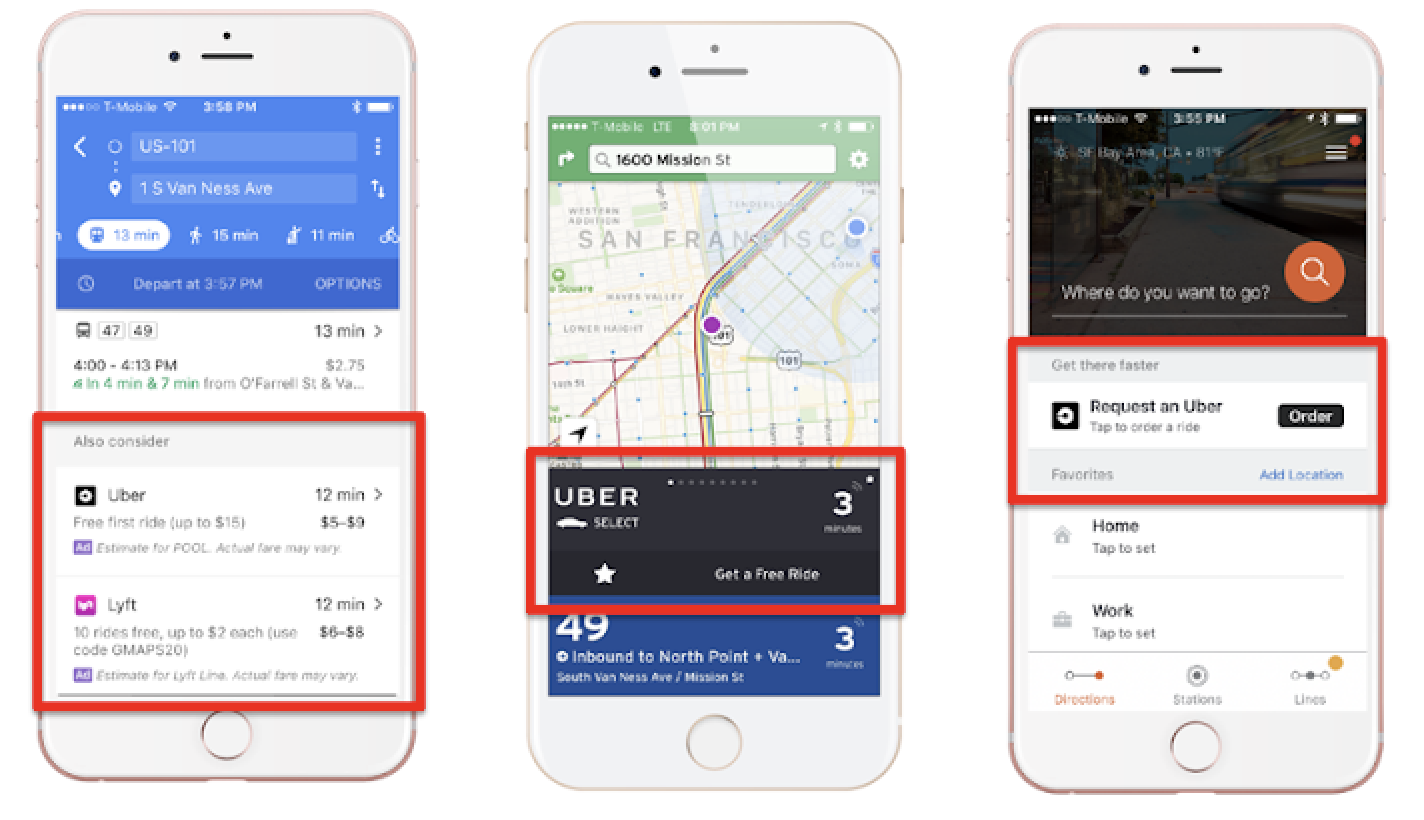
Popular transit apps prominently advertise TNCs, which may divert people away from transit
This Ridership Initiative guest post—by Technology Transit Project Manager Jason Lee and San Francisco Fellow Nealay Vasavda of the San Francisco Municipal Transportation Agency (SFMTA)—is our latest from transit agency staff working to increase ridership in a rapidly-changing transportation landscape. Going beyond the City’s comprehensive Muni Forward program, the SFMTA is undertaking an ambitious new program to improve real-time information for transit customers, making it easier to choose transit in one of the nation’s most diverse mobility ecosystems. If your agency would like to share your story or if you would like to hear from a specific agency or about a particular topic, let us know by emailing [email protected]
After increasing 36 percent between 1995 and 2014, U.S. transit ridership has begun to fall, even as the economy and demand for transportation services have grown—with bus ridership plunging 9 percent since 2014. Some speculate that low gas prices, gentrification, Transportation Network Company (TNC) services such as Uber and Lyft, and rising car ownership are among the factors driving this decline. Left unaddressed, these ridership losses could fuel a cyclical downward spiral of heavier congestion, slower service, fare increases and service reductions leading to further ridership losses.
In San Francisco, any trend away from transit is especially alarming, given more than a century as a leader in public transit. In 1912, the City launched Muni, the first municipally-owned transit system in the United States and, in 1973, established its landmark Transit-First Policy, which explicitly prioritizes transit, bicycling and walking. As a 47-square mile city surrounded by water on three sides, an already-congested San Francisco is projected to face a 26-percent population increase from 870,000 to 1.1 million residents by 2040. There is simply no room to accommodate more cars.
Given this reality, San Francisco recently adopted an ambitious goal to serve 80-percent of trips by sustainable modes by 2030 after achieving its previous 50-percent sustainable mode-share goal in 2017. In addition to pursuing initiatives such as transit-only lanes, transit signal priority, new buses and trains, and increased service frequency, the SFMTA is turning to a less-conventional strategy to build ridership: real-time transit information.
In 1999, the SFMTA helped revolutionize the transit-riding experience by launching NextMuni, the nation’s first large-scale real-time transit information system—a model now widely replicated elsewhere. Nearly two decades later, NextMuni continues to deliver vehicle arrival predictions through countdown signs at stations and shelters, and SFMTA provides data used in third-party trip-planning apps.
Times have changed, however. The explosion of app-based carsharing, bikesharing, private commuter vans, scooters, and TNCs have raised traveler expectations. Easy-to-use apps not only have altered how individuals make travel choices but also have led to unanticipated, large-scale consequences. Perhaps most significantly, TNCs now generate 170,000 weekday vehicle trips in San Francisco and comprise roughly a quarter of downtown rush-hour traffic. Typically carrying one or two passengers at a time, TNCs tend to concentrate in areas already well-served by Muni—slowing transit speeds and reducing ridership and fare revenue.
In this environment, the SFMTA is seizing an opportunity to innovate as the current real-time customer information system approaches the end of its useful life. Reflecting a customer-centric approach, the SFMTA conducted extensive public outreach to inform the design of the Next Generation Customer Information System. This effort included focus groups involving participants with and without disabilities from diverse sociodemographic backgrounds, as well as a comprehensive survey of over 30 questions in both online and paper formats translated in English, Spanish and Chinese. The survey yielded more than 5,800 responses.
The SFMTA was particularly interested in answering a key question: Can changes to the presentation and content of real-time information alter the psychology of mode choice and boost ridership?
To find out, the SFMTA asked survey respondents four “situational” questions involving scenarios where they were going home from work or school and had to wait 20 minutes—not unusual at off-peak times or during a service gap. Without access to real-time information, only 14 percent indicated they would wait all 20 minutes before abandoning transit and seeking other transportation.
In Scenario 1, respondents saw a digital sign at their stop, predicting a 20-minute wait. In Scenario 2, the sign offered an alternative route three blocks away, arriving in 8 minutes: a plausible situation since San Francisco has many closely-spaced parallel routes. In Scenario 3, respondents consulted their smartphone and saw a 20-minute wait before walking to their stop. Finally, Scenario 4 mirrored Scenario 3 except that a TNC advertisement accompanied the prediction; such ads are now common on popular transit apps.

Popular transit apps prominently advertise TNCs, which may divert people away from transit
The presentation and content of real-time information influenced mode choice significantly, even when Muni service itself did not change.
Survey respondents choosing Muni—either waiting 20 minutes or finding an alternative transit route—increased from 45 percent with basic information (the countdown sign predicting arrivals, in Scenario 1) to as much as 72 percent (with a smartphone app, in Scenario 3) or 82 percent (the countdown sign suggesting an alternative, in Scenario 2). Meanwhile, TNC advertisements on apps (in Scenario 4) reduced transit mode share by 7 percentage points.
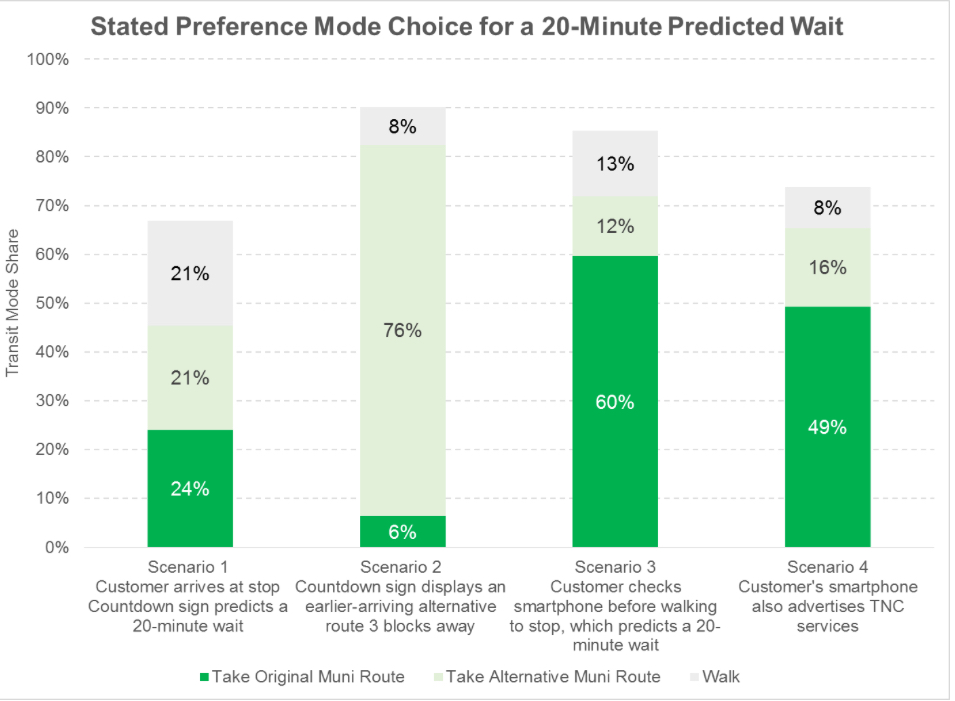 The presentation and content of real-time information significantly influence transit mode share
The presentation and content of real-time information significantly influence transit mode share
Not surprisingly, income had the strongest demographic influence on transportation choice. However, the survey showed that targeted and contextual information could mitigate its effect.
With a stop’s countdown sign showing a 20-minute wait (Scenario 1), people were less likely to ride Muni as their income increased—a 29-percentage-point decline between the lowest and highest income brackets. In contrast, when the countdown sign presented a nearby alternative (Scenario 2) or when customers consulted their smartphones before walking to their stop (Scenario 3), transit’s mode share was much higher—and differences among income groups virtually disappeared. However, the income gap reappeared when customers saw TNC advertisements on their mobile app (Scenario 4).
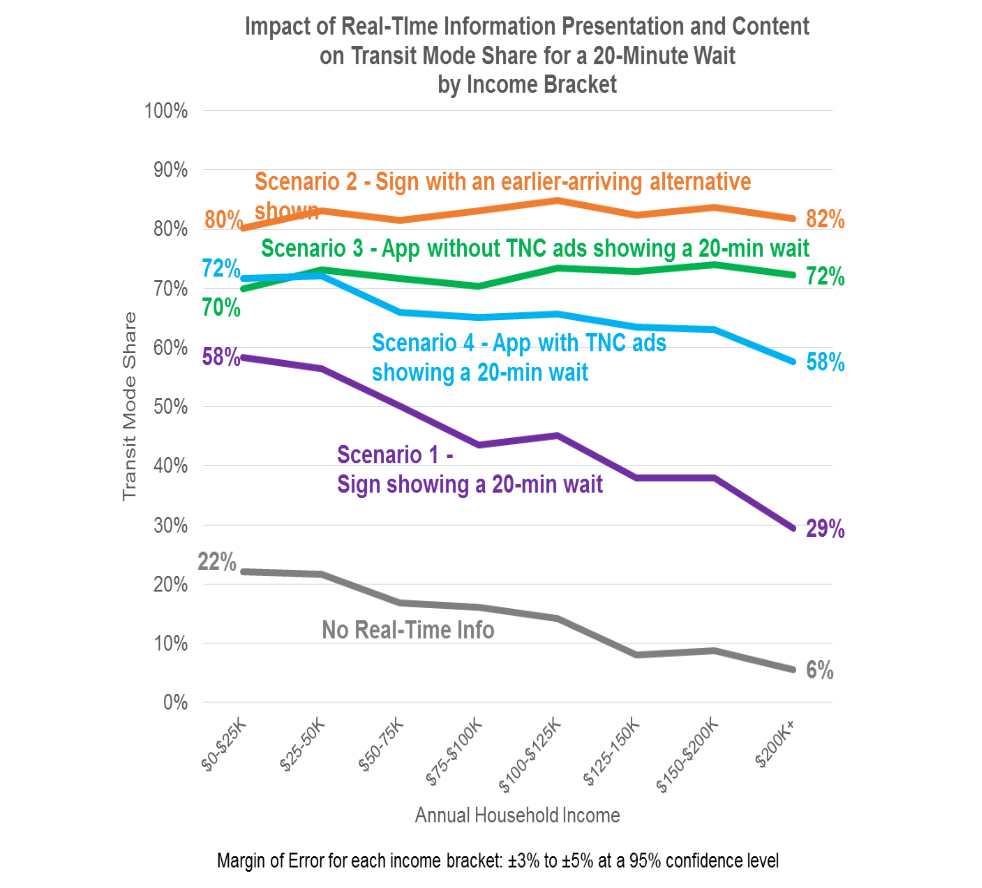 Better real-time information can improve ridership overall and reduce disparities in transit usage across income groups
Better real-time information can improve ridership overall and reduce disparities in transit usage across income groups
Incentivizing unlimited-ride passes over single-ride tickets also appears to boost transit mode share. Among frequent Muni users (4+ days per week), pay-as-you-go respondents were 5 to 14 percentage points less likely to ride transit than pass holders. Without an upfront financial commitment to transit, pay-as-you-go customers may be deliberating more about their options for each trip and choosing other transportation modes. To promote ridership, the SFMTA is introducing a new day pass and lowering visitor pass prices on selected fare media, as well as capping rate increases for its combined Muni/BART monthly pass.
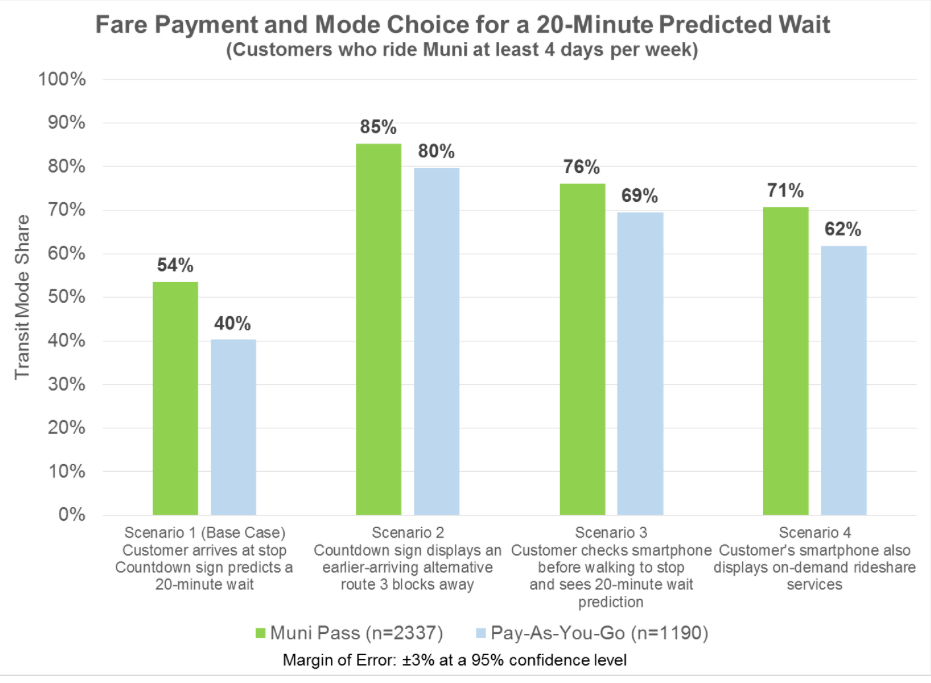 Incentivizing transit passes over individual ride payments can attract more people to transit
Incentivizing transit passes over individual ride payments can attract more people to transit
Incorporating survey results and other public input, the SFMTA is planning key innovations for the Next Generation Customer Information System, including:
- Improving prediction accuracy
- Implementing alternatively-powered signage at unpowered shelters and stops
- Showing nearby alternative routes with shorter waits on digital signage at stops
- Balancing ridership loads by providing crowding alerts
- Displaying transfer connection times, service delays and disruptions on future signage on-board vehicles
- Providing real-time stop accessibility information and elevator/escalator outage alerts
- Using mobile technologies to understand customer preferences and improve service and operational planning
Over the past two decades, San Francisco has emerged as a real-life laboratory to explore how technology can radically alter the transportation landscape. Yet the proliferation of TNCs and other private options has raised the prospect of a two-tiered, income-based transportation system in a region already confronting gentrification, widening income inequality and racial disparities.
Whether in San Francisco or other cities, the next generation of real-time information has the potential to counter recent trends by altering the psychology of mode choice and thereby boosting transit ridership. It will also broaden transit’s constituency and deepen public support for system investments that benefit all customers, including historically-disadvantaged populations—ultimately helping cities grow both sustainably and equitably.
Detailed survey findings are available in the paper, “Moving Minds: The Next Generation of Real-Time Transit Information in San Francisco,” co-written by Jason Lee, Nealay Vasavda, and former Mayor’s Innovation Fellow William Tyner. The paper will be published in the 2018 Transportation Research Record: Journal of the Transportation Research Board. The authors would also like to acknowledge colleagues from SFMTA’s Communications & Marketing, Finance & Information Technology, Sustainable Streets, Taxi & Accessible Services and Transit divisions for their contributions in helping shape requirements for the Next Generation Customer Information System.
 On the Brink: Will WMATA’s Progress Be Erased by 2024?
On the Brink: Will WMATA’s Progress Be Erased by 2024?
The experience of being a WMATA rider has substantially improved over the last 18 months, thanks to changes the agency has made like adding off-peak service and simplifying fares. Things are about to get even better with the launch of all-door boarding later this fall, overnight bus service on some lines starting in December, and an ambitious plan to redesign the Metrobus network. But all of this could go away by July 1, 2024.
Read More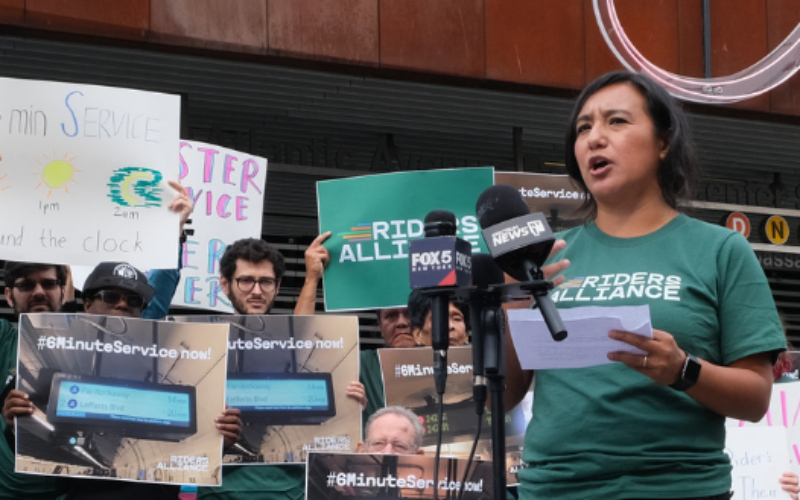 Built to Win: Riders Alliance Campaign Secures Funding for More Frequent Subway Service
Built to Win: Riders Alliance Campaign Secures Funding for More Frequent Subway Service
Thanks to Riders' Alliance successful #6MinuteService campaign, New York City subway riders will enjoy more frequent service on nights and weekends, starting this summer. In this post, we chronicle the group's winning strategies and tactics.
Read More